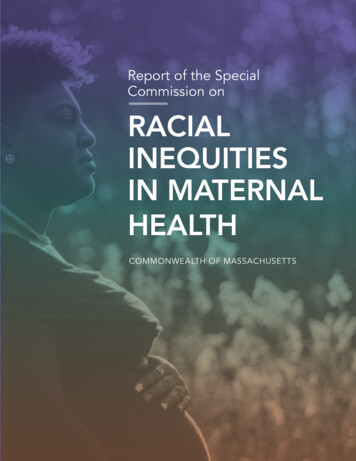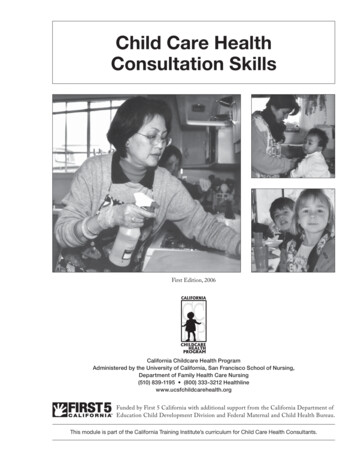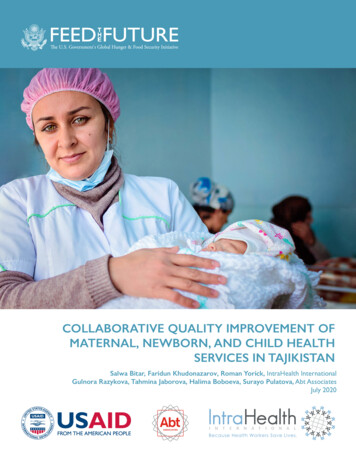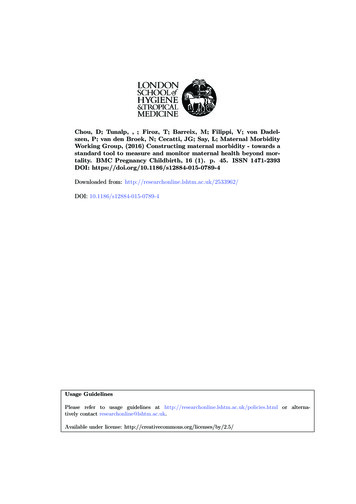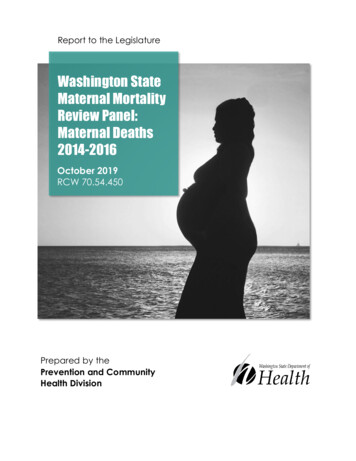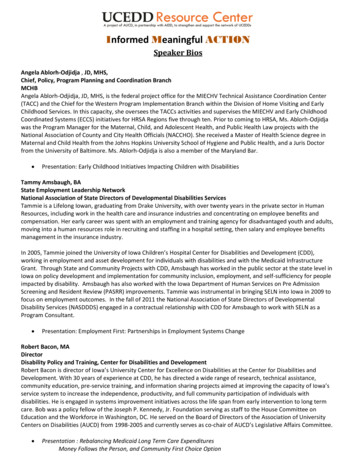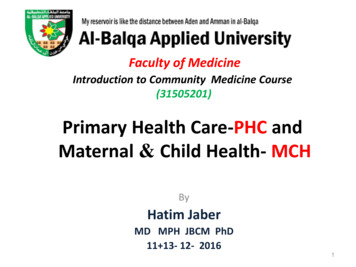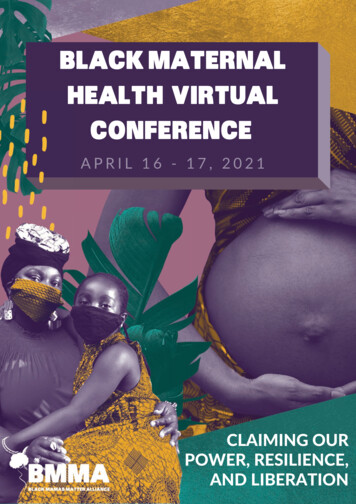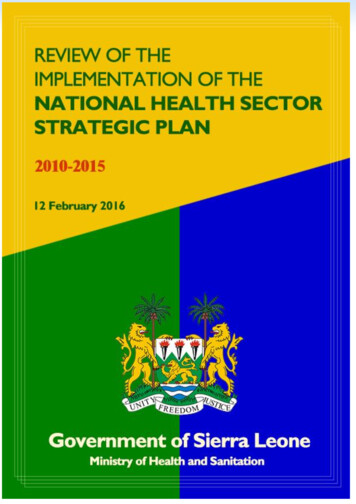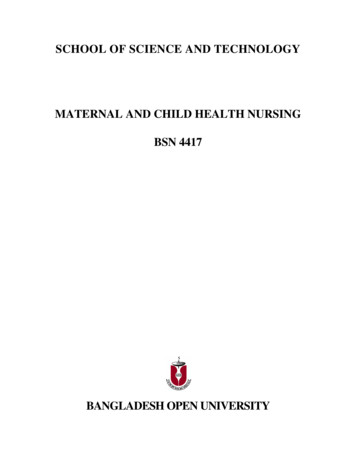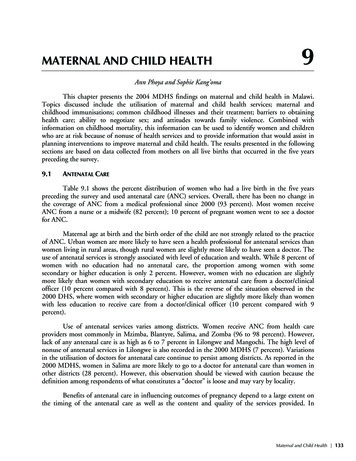
Transcription
MATERNAL AND CHILD HEALTH9Ann Phoya and Sophie Kang’omaThis chapter presents the 2004 MDHS findings on maternal and child health in Malawi.Topics discussed include the utilisation of maternal and child health services; maternal andchildhood immunisations; common childhood illnesses and their treatment; barriers to obtaininghealth care; ability to negotiate sex; and attitudes towards family violence. Combined withinformation on childhood mortality, this information can be used to identify women and childrenwho are at risk because of nonuse of health services and to provide information that would assist inplanning interventions to improve maternal and child health. The results presented in the followingsections are based on data collected from mothers on all live births that occurred in the five yearspreceding the survey.9.1ANTENATAL CARETable 9.1 shows the percent distribution of women who had a live birth in the five yearspreceding the survey and used antenatal care (ANC) services. Overall, there has been no change inthe coverage of ANC from a medical professional since 2000 (93 percent). Most women receiveANC from a nurse or a midwife (82 percent); 10 percent of pregnant women went to see a doctorfor ANC.Maternal age at birth and the birth order of the child are not strongly related to the practiceof ANC. Urban women are more likely to have seen a health professional for antenatal services thanwomen living in rural areas, though rural women are slightly more likely to have seen a doctor. Theuse of antenatal services is strongly associated with level of education and wealth. While 8 percent ofwomen with no education had no antenatal care, the proportion among women with somesecondary or higher education is only 2 percent. However, women with no education are slightlymore likely than women with secondary education to receive antenatal care from a doctor/clinicalofficer (10 percent compared with 8 percent). This is the reverse of the situation observed in the2000 DHS, where women with secondary or higher education are slightly more likely than womenwith less education to receive care from a doctor/clinical officer (10 percent compared with 9percent).Use of antenatal services varies among districts. Women receive ANC from health careproviders most commonly in Mzimba, Blantyre, Salima, and Zomba (96 to 98 percent). However,lack of any antenatal care is as high as 6 to 7 percent in Lilongwe and Mangochi. The high level ofnonuse of antenatal services in Lilongwe is also recorded in the 2000 MDHS (7 percent). Variationsin the utilisation of doctors for antenatal care continue to persist among districts. As reported in the2000 MDHS, women in Salima are more likely to go to a doctor for antenatal care than women inother districts (28 percent). However, this observation should be viewed with caution because thedefinition among respondents of what constitutes a “doctor” is loose and may vary by locality.Benefits of antenatal care in influencing outcomes of pregnancy depend to a large extent onthe timing of the antenatal care as well as the content and quality of the services provided. InMaternal and Child Health 133
Malawi, women are advised to have a minimum of four ANC visits spread throughout thepregnancy, with the first visit in the first trimester.Table 9.1 Antenatal carePercent distribution of women who had a live birth in the five years preceding the survey by antenatal care (ANC) provider during pregnancy for the most recent birth, according to background characteristics, Malawi Nurse/midwifePatientattendantAge at birth 2020-3435-4910.010.08.882.582.481.90.91.01.2Birth order12-34-56 hattendant/otherNo MzimbaSalimaThyoloZombaLilongweMulanjeOther 3891,0132962,981EducationNo educationPrimary 1-4Primary 5-8Secondary 8852,0212,485880Wealth 4.60.2100.07,271TotalNote: If more than one source of ANC was mentioned, only the provider with the highest qualifications is considered in this tabulation.134 Maternal and Child Health
Table 9.2 presents information about the number and timing of ANC visits. For 57 percentof births, mothers meet the recommended number of four or more antenatal care visits. This is thesame level reported in the 2000 MDHS. Women in urban areas are more likely than rural women togo for antenatal care visits.Messages regarding the importance of initiating antenatal care in the first trimester have notmade a significant impact on the timing of antenatal care. Table 9.2 shows that only 8 percent ofwomen initiated antenatal care before the fourth month of pregnancy, about the same as found inthe 2000 MDHS (7 percent). While urban women make more frequent visits for antenatal care thanrural women, they initiate the ANC visit at about the same time as their rural counterparts (5.8-5.9months). The persistent delay in initiating antenatal care indicates that a large proportion ofpregnant women in Malawi miss out on intended benefits of early antenatal care services.Table 9.2 Number of antenatal care visits and timing of first visitPercent distribution of women who had a live birth in the five years preceding thesurvey by number of antenatal care (ANC) visits for the most recent birth, and bythe timing of the first visit according to residence, Malawi 2004Number and timingof ANC visitsNumber of ANC visitsNone12-34 Don't .541.22.80.3TotalMedian months pregnant at first visit(for those with ANC)100.0100.0100.05.85.95.9Number of women1,0416,2317,271TotalNumber of months pregnantat time of first ANC visitNo antenatal care 44-56-78 Don't know/missingIn addition to the number and timing of ANC visits, another important aspect of antenatalcare is the content and quality of services. Women who received antenatal care in the five yearspreceding the survey were asked what services they received. The limited content of antenatal careservices in Malawi indicates that women are not getting the care that would assist in theidentification and management of complications that can have a negative impact on the mother andher baby.Table 9.3 shows that seven in ten women report that they were told about pregnancycomplications and where to go in case of problems during pregnancy. The most frequent checks forMaternal and Child Health 135
Table 9.3 Components of antenatal carePercentage of women with a live birth in the five years preceding the survey who received antenatal care for the most recent birth, by content of antenatalcare, and percentage of women with a live birth in the five years preceding the survey who received iron tablets or syrup or antimalarial drugs for the mostrecent birth, according to background characteristics, Malawi 2004BackgroundcharacteristicAmong women who received antenatal careInformed Informedof signs of where topregnancy go withBloodUrinecomplica- complica- WeightHeightpressure sampletionstionsmeasured measured measured Received Receivedironantitabletsmalarialor syrupdrugsNumberofwomenAge at birth 2.877.11,2934,9791,000Birth order12-34-56 MulanjeOther 1,0132962,981EducationNo educationPrimary 1-4Primary 5-8Secondary ,0212,485880Wealth 6,93079.480.77,271pregnant women during an antenatal visit are measuring weight (95 percent) and blood pressure(78 percent). Blood samples were taken from 36 percent of women, and a urine sample was collectedfrom 21 percent of pregnant women. For nine in ten women, the baby’s heartbeat was checked; fortwo in three women, their eyes were examined during an antenatal visit for their most recent birth.These figures, as well as the coverage of iron supplementation and antimalarial treatments, aresimilar to those found in the 2000 MDHS, suggesting that there is no improvement in theutilisation of health services for expectant mothers.136 Maternal and Child Health
There are variations inthe provision of services duringantenatal visits across subgroupsof women. In general, women inurban areas, in the NorthernRegion, more educated womenand women in the highestwealth quintile are more likelythan other women to receivequality care during pregnancy.At the district level, the contentof antenatal care varies widely.Blood pressure measurementswere taken for only 63 percentof women in Machinga. Thecollection of blood and urinesamples is even less common.The collection of blood samplesranges from 14 percent ofwomen in Kasungu to 58percent in Zomba. Women inZomba seem to get the bestantenatal care services based onthe types of checks duringpregnancy.Table 9.4 shows that 85percent of women who had abirth in the five years precedingthe survey report that theyreceived at least one tetanustoxoid injection during thepregnancy. The coverage oftetanus toxoid injection has notchanged since 1992 (85-86percent). Table 9.4 also showsthat only 66 percent of womenhad two or more tetanus toxoidinjections. This figure is lowerthan that reported in the 1992MDHS (73 percent).Table 9.4 Tetanus toxoid injectionsPercent distribution of women who had a live birth in the five years preceding the survey by number of tetanus toxoid injections received during pregnancy for the mostrecent birth, according to background characteristics, Malawi 2004TwoDon'tOneor more know/injection injections yoloZombaLilongweMulanjeOther 91,0132962,981EducationNo educationPrimary 1-4Primary 5-8Secondary lth oundcharacteristicNoneAge at birth rth order12-34-56 l9.615.7RegionNorthernCentralSouthernYounger women, women pregnant with their first child, and women who live in urban areasare more likely to have received two or more doses of tetanus toxoid injections. Women withsecondary or higher education and women in the highest wealth quintile are also more likely thanother women to have two or more tetanus toxoid injections. Across districts, coverage of two ormore doses of tetanus toxoid is 59 to 60 percent in Mulanje, Kasungu, and Thyolo and 74 to 75percent in Mangochi and Salima.Maternal and Child Health 137
The aim of antenatal care is to minimise adverse maternal and fetal outcomes of pregnancy.Data in Table 9.5 and Figure 9.1 show that common complications among women are high bloodpressure (14 percent) and swollen feet (13 percent), both indications of pre-eclampsia. Anaemia isreported by 12 percent of women, and 6 percent of women report experiencing bleeding duringpregnancy. It is important to note that the data show self-reported complications as opposed tomedically documented problems.Table 9.5 Complications during pregnancyAmong women who had a birth in the five years preceding the survey, percentage who had specific complications associated with the pregnancy leading to the most recent birth, by background characteristics,Malawi 2004High bloodpressureSwollenfeetAnaemiaNumber of ANC visitsNone1-34 4Age at birth 45.27.81,2934,9791,000Birth order12-34-56 eOther ,981EducationNo educationPrimary 1-4Primary 5-8Secondary 66.35.03.21,8852,0212,485880Wealth 212.15.67,271BackgroundcharacteristicNote: Total includes 53 cases with number of ANC visits missing.na Not applicable138 Maternal and Child HealthBleedingNumber ofwomen
Figure 9.1 Complications During Pregnancy161414131212Percent10866420High blood pressureSwollen feetAnaemiaType of complicationBleedingMDHS 2004These problems are slightly more prevalent in older women and women with higher orderbirths. Women in rural areas and those living in the Central Region are also more likely to reporthaving problems during pregnancy. In general, a woman’s education and wealth status have noassociation with the likelihood of having pregnancy complications. Across districts, however, thereare wide variations. Women in Kasungu are most likely to report problems during pregnancy, whilewomen in Machinga are the least likely to do so.Table 9.6 shows places where women sought advice and care for complications experiencedin pregnancy. The 2004 MDHS did not explore the quality or effect of care received from thesefacilities. For any complication, the most common source of treatment is a public health facility (44to 57 percent). About one in five women went to a private health facility for assistance withpregnancy complications. While 85 percent of pregnant women sought treatment for anaemia, onein three women with high blood pressure, swollen feet, and bleeding left the problem untreated.Maternal and Child Health 139
Table 9.6 Treatment for complications during pregnancyAmong women with a birth in the five years preceding the survey who had complications associated withthe most recent pregnancy, percentage who sought advice or treatment, by type of complication, Malawi2004Health 517.456.920.143.718.1Type ofcomplicationPublicsectorPrivatesectorHigh blood pressure47.0Swollen feetAnaemiaBleedingOtherNottreatedNumber ofwomen 13.75.415.58770.55.34.331.9406ASSISTANCE AND MEDICAL CARE AT DELIVERYAn important component in the effort to reduce the health risks of mothers and children isto increase the proportion of babies that are delivered in facilities where skilled attendance isavailable. Services in a health facility include trained health workers, appropriate supplies, equipmentto identify and manage complications in a timely manner, and maintenance of hygienic conditionsto prevent infections. The 2004 MDHS respondents were asked to report the place of birth of allchildren born in the five years before the survey. Table 9.7 shows that 57 percent of births took placein a health facility. This figure shows that there has been no notable improvement from the 1992and 2000 MDHS surveys (both 55 percent). Government-run health facilities were used for42 percent of the births, while private facilities managed 15 percent of births. A considerableproportion of births took place at home, either in the respondent’s home (29 percent) or thetraditional birth attendant (TBA)’s home (12 percent).Children born to women less than 34 years of age and first-order births are more likely to bedelivered in a heath facility than other children. Similarly, the majority of births in urban areas,births to women with secondary or higher education, and to women in the highest wealth quintileoccurred in a health facility. The proportion of births delivered in a health facility varies from lessthan 50 percent in Kasungu and Salima (43 percent and 46 percent, respectively) to 79 percent inBlantyre. The assistance of a TBA during delivery is most common in Salima (23 percent) and leastcommon in Mangochi (4 percent).140 Maternal and Child Health
Table 9.7 Place of deliveryPercent distribution of live births in the five years preceding the survey by place of delivery, according to background characteristics,Malawi 2004BackgroundcharacteristicHealth facilityPublicPrivatesectorsectorMother's age at birth 2020-3435-4943.342.337.2Birth order12-34-56 imbaSalimaThyoloZombaLilongweMulanjeOther 7245254416366763125755441,4894374,414EducationNo educationPrimary 1-4Primary 5-8Secondary .0100.02,9033,1023,6371,127Antenatal care visits1None1-34 1.41.00.00.00.1100.0100.0100.03372,7384,149Wealth irthsNote: Private health facility includes Mission health facility. Total includes 53 cases with the number of antenatal care visits missing.1Includes only the most recent birth in the five years preceding the survey.Maternal and Child Health 141
The 2004 MDHS asked questions about the person who assisted with the delivery. Themajority of births were attended by medical professionals, 50 percent by a nurse or midwife, 6percent by a doctor, and 1 percent by a patient attendant. In the four years since the 2000 MDHSthere has been a slight increase in the proportion of births that are attended by a doctor—from 5 to6 percent. The role of traditional birth attendants (TBAs) in delivery assistance has also increased—from 23 to 26 percent (Table 9.8).Table 9.8 Assistance during deliveryPercent distribution of live births in the five years preceding the survey by person providing assistance during delivery, according tobackground characteristics, Malawi erMother's age at birth 27.7Birth order12-34-56 MzimbaSalimaThyoloZombaLilongweMulanjeOther districtsNo ationNo educationPrimary 1-4Primary 5-8Secondary 0100.0100.0100.02,9033,1023,6371,127Wealth kgroundcharacteristicNote: If the respondent mentioned more than one attendant, only the most qualified attendant is considered in this tabulation.142 Maternal and Child Health
While 78 percent of births in Blantyre were assisted by a health professional, thecorresponding proportions in Kasungu and Salima are 43 and 46 percent, respectively (Figure 9.2).Delivery by a TBA is most common in Salima (42 percent) and Kasungu (39 percent), whileBlantyre has the lowest level of TBA deliveries (14 percent). In rural areas 15 percent of births areattended by relatives or other persons who may not be trained in assisting deliveries, and 29 percentof the births are assisted by TBAs. With poor quality and inadequate antenatal care, as well aslimited access to skilled attendance at delivery, the concept of safe pregnancy and child birth maynot be realised by some Malawian women, especially those residing in rural areas.Figure 9.2 Assistance at Delivery from a Health Professional,by Residence and anjeOther 8090PercentMDHS 2004One outcome of pregnancy assessed during the survey was assisted operative delivery such ascaesarean section (C-section). This operation is one of the emergency obstetric care functionsrecommended for addressing some complications that contribute to high maternal mortality.According to the survey data, 3 percent of births in the five years preceding the survey were deliveredby C-section. This rate is similar to that recorded in the 2000 MDHS. The stagnation in the Csection rate since 1992 in Malawi suggests that emergency obstetric care is limited to a smallproportion of women.Table 9.9 shows that C-section deliveries are more common among births to youngerwomen, for the first child, births to women with higher education, and women residing in urbanareas. In four districts, Blantyre, Mzimba, Thyolo, and Zomba, the proportion of births delivered byC-section is slightly higher (4 to 5 percent) than the national average of 3 percent. The higherproportion of C-section operations in Blantyre and Zomba was also reported in the 2000 MDHS.Maternal and Child Health 143
Table 9.9 Delivery characteristicsPercentage of live births in the five years preceding the survey delivered by caesarean section, and percent distribution bybirth weight and by mother's estimate of baby's size at birth, according to background characteristics, Malawi 2004BackgroundcharacteristicBirth weightDelivery Less 2.5 kg Don'tknow/orthanby Csection 2.5 kg more missing TotalSize of child at birthSmaller Average Don'tknow/orthanVerysmall average larger missing TotalNumberofbirthsMother's age at birth .03.02.32.4100.0100.0100.02,2057,3211,246Birth order12-34-56 gweMulanjeOther 4894374,414EducationNo educationPrimary 1-4Primary 5-8Secondary 02,9033,1023,6371,127Wealth 709Total3.15.343.451.3100.03.811.782.02.5100.0 10,771Women who gave birth in the five years before the survey were asked whether their baby wasweighed at birth and, if so, what the baby’s weight was. Interviewers were instructed to use anywritten record of birth weight available. In addition, because many women do not deliver at a healthfacility, and hence the baby was not weighed, all respondents were asked for their own subjectiveassessment of their child’s size. Table 9.9 also provides information on the birth weights according tothe background characteristics of the mother. Birth weight was reported for slightly less than one-144 Maternal and Child Health
half of the births. Forty-three percent of all births (or 89 percent of those with a birth weightreported) were reported to be of 2.5 kilograms or more. Five percent of births (11 percent of thosewith a birth weight) were less than 2.5 kilograms, the cutoff point below which a baby is consideredto have low birth weight. The proportion of low birth weight babies is 7 percent or higher inBlantyre, Kasungu, Machinga, and Mzimba.Regarding the size of the child at birth, 82 percent of births were reported by the mother asbeing average or larger than average in size. For 16 percent of births, mothers said that their childwas smaller than average (12 percent) or very small (4 percent); in the 2000 MDHS, 17 percent ofbirths were reported as smaller than average or very small. District estimates of low birth weight,using subjective assessment, vary from a low of 11 percent in Mulanje to 22 percent in Kasungu.9.3POSTNATAL CAREPostnatal care is an important component of obstetric and neonatal care aimed at preventingand managing any complications that may endanger the survival of the mother and the baby.Postnatal care is therefore recommended immediately after the birth of the baby and placenta to
pregnant women in Malawi miss out on intended benefits of early antenatal care services. Table 9.2 Number of antenatal care visits and timing of first visit Percent distribution of women who had a live birth in the five years preceding the survey by number of antenatal care (ANC) visits for the most recent birth, and by
